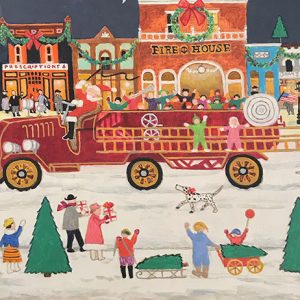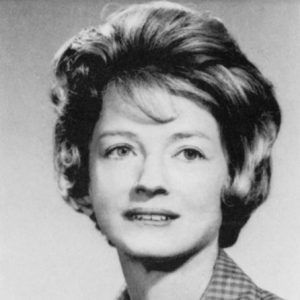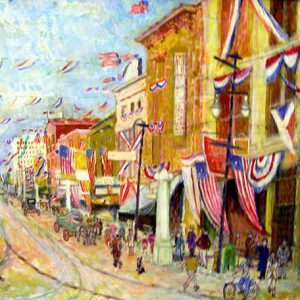calsfoundation@cals.org
Josephine Hutson Graham (1915–1999)
Josephine Hutson Graham was a prolific artist, educator, author, and folklorist of Arkansas’s White River culture and cuisine. She won many local, regional, and national art awards and held more than twenty one-woman shows throughout the South and Southwest, as well as shows in New York, Washington DC, and Dallas, Texas.
Josephine Hutson was born in Newport (Jackson County) on April 12, 1915, to Thomas Hutson (a cotton broker) and Mary Bailey Hutson; she had one younger brother. After high school graduation in Newport, Graham attended the University of Texas for three years before transferring to the University of Arkansas (UA) in Fayetteville (Washington County). She earned a bachelor’s degree in English. She married Thomas Nathan Graham, a farmer and cotton ginner from Tuckerman (Jackson County), in 1937, and they had one son. Her husband died in 1946, and in 1955, she married Marion H. Gray, a prominent Little Rock (Pulaski County) dentist; they had no children. Graham and Gray divorced in 1957.
A painter since childhood, Graham had long been interested in art but did not paint seriously until later in life, when she studied under German expressionist Max Beckmann at the University of Colorado, where she received a BFA degree. Graham studied art at Columbia University, where she earned a MFA degree with high honors in 1961. While in New York, she also studied at Parsons School of Design and worked at the Art Students League under sculptor Jose de Creft.
Influenced by Max Beckmann, Ralston Crawford, and Richard Diebenkorn, Graham created formalist paintings early in her career. In 1962, Graham had her first exhibit at the Explorer Gallery in New York, where she presented thirty dramatic architectural studies (such as Jackson Square No.2), the theme of much of her early work. Graham loved old and historic buildings (she painted The Old State House in 1963) and, inspired by history, she often captured their masonry walls, textures, structures, columns, and arches in her early haunting representational art.
The people and stories of Newport and the White River region inspired her work and were often the subject matter of her paintings of rural Arkansas life. In 1974, she published Suggin Cookbook (pronounced “soo-gin”), a collection of old-time recipes from handwritten records of her family and other pioneer families in the Jacksonport (Jackson County) area who emigrated from Derry, Ireland, in 1719. Graham also founded the Suggin Folklife Society; in 1981, it had 200 members from eight states. She explained that “Suggin” was a term used playfully and lovingly to mean “a somewhat uncouth and unsophisticated person living in a rural area or small town along the White River.”
Graham is perhaps best known for her authentic primitive works such as Flood at Granny’s, Saturday Town, Suggins, Bottom Rail’s On Top, and Even a Blind Sow Gets an Acorn Once in a While. She created more than 100 “suggin” paintings depicting folk history of rural Depression-era scenes. Many of her paintings were signed “Josus,” a childhood nickname given to her by her grandmother, Josephine Phillips. At one time, according to her son, Graham’s primitive-style paintings were more popular in New York than in Arkansas.
Graham’s portraits of public figures include Hillary Rodham Clinton, Joe Purcell, Arkansas Supreme Court Justice George Rose Smith, and many other notable Arkansans.
In 1970, Graham, along with four other artists—Doris Williamson Mapes, Bruce R. Anderson, Catherine Tharp Altvater, and Edwin C. Brewer—founded and incorporated the Mid-Southern Watercolorists in Little Rock. This is a nonprofit organization formed to elevate the stature of watercolor art. Graham served as president of the organization.
During America’s bicentennial celebration in 1976, Graham was commissioned by the Southwestern Bell corporation to paint a collage made up of forty artifacts, memorabilia, and scenes from Arkansas history. A color reproduction of this painting, Arkansas, Arkansas, was featured on the cover of the 1977 Southwestern Bell Telephone Book for Little Rock and suburban areas; more than 200,000 copies of this book were distributed to customers. Today, the painting is part of AT&T’s corporate art collection.
Graham taught art in elementary grades, junior high school, and college. During the 1960s, she taught art at the University of Arkansas at Little Rock (UALR) and what is now the University of Central Arkansas (UCA) in Conway (Faulkner County). Graham was a member of the American Watercolor Society and the National Association of Women Artists.
Graham died on January 22, 1999, in Little Rock.
For additional information:
Albin, Edgar A. “An LRU Artist-Teacher Has an Unusual Exhibit: Her Subjects—Old Buildings.” Arkansas Gazette, April 22, 1962, p. 4E.
“Art Instructor at Little Rock U Has Solo Showing at New York Gallery.” Arkansas Gazette, February 4, 1962, p. 10C.
Graham, Josephine. Suggin Cookbook. Newport, AR: Suggin Productions, 1974.
Lewis, Bill. “Suggins, a Vision of ‘Poor,’ Lives amid ‘Constructions’ at Arts Center Exhibition.” Arkansas Gazette, November 4, 1971, p. 1B.
Rowland, Betty. “Josephine Graham: A Newport Lady with a Certain (“Ootch over There”) Suggin Style.” Arkansas Times, February 1981, pp. 65–66.
Thomas A. Teeter
Little Rock, Arkansas
 Food and Foodways
Food and Foodways Fire House Santa
Fire House Santa  Josephine Graham
Josephine Graham  Main Street
Main Street 



I was a student of Josephine Graham at Little Rock University from 1963 to 1965. I am now a professor of art at Houston Community College. I am seventy-six years old and, yes, still teaching. I have been inspired in my creative and professional work by the same of Mrs. Graham. Her insistence on perfection as you, the artist, sees it and the greater importance of “seeing” have always been part of my work as an artist/painter. I try to give my 120 students per semester a similar process to follow. A chance encounter at the Arkansas Arts Center on a cold winter afternoon in Little Rock many years after receiving my MFA allowed me to offer Mrs. Graham my thanks for much inspiration.